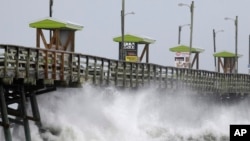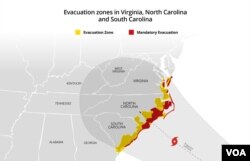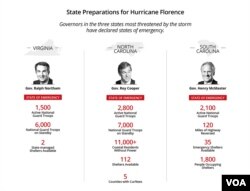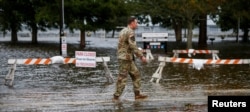The National Hurricane Center said Thursday that "a life-threatening storm surge" was likely along the North and South Carolina coasts as Hurricane Florence approached the U.S. Eastern Seaboard.
Late Thursday, Florence was downgraded to a Category 1 hurricane. The storm's eye was 80 kilometers south of Morehead City, North Carolina, and 95 kilometers east-southeast of Wilmington, North Carolina, and was moving northwest toward land at a scant 9 kilometers per hour, with top sustained winds of 150 kph. The center of the storm was expected to hit North Carolina's southern coast by Friday.
The storm's slow pace was giving it more time to churn and suck up water. Heavy bands of rain and tropical storm force winds were already sweeping across the barrier islands off North Carolina and along the southeastern coast of the state.
By the time the storm leaves the region, forecasters expect that it will have dumped 50 to 70 centimeters of rain in coastal areas, with some parts possibly being inundated with up to 100 centimeters. Further inland, rain totals could reach 30 centimeters in the Carolinas and up to 24 centimeters in the rest of the Carolinas and in southwestern Virginia. Tornadoes were also possible.
Also late Thursday, far out in the Atlantic, Joyce strengthened into a tropical storm, joining Tropical Storm Helene near the Azores and Tropical Storm Isaac, moving west across the eastern Caribbean.
Earlier Thursday, even though Florence had weakened to then a Category 2 system, forecasters said it remained a destructive force.
"Just because the wind speeds came down and the intensity of this storm came down to a Category 2, please do not let your guard down," Brock Long, the Federal Emergency Management Agency administrator, told reporters Thursday in Washington.
Forecasters said the storm surge — or wall of water — that the hurricane's winds and forward movement push ashore could cause normally dry areas to be flooded.
Surges of up to 4 meters could inundate the area from Cape Fear to Cape Lookout, North Carolina, with surges ranging from half a meter to 3 meters in coastal areas from Edisto Beach, South Carolina, to coastal areas extending north into North Carolina.
Long said the surges "are going to be a major problem way up into the streams and tributaries that come out of sound areas." He asked citizens in danger zones to heed warnings because "your time is running out."
Ignoring evacuation order
But some people were refusing to heed evacuation warnings.
"Leaving is such a problem with the traffic going out," a woman named Jennie told VOA Thursday afternoon as she strolled along the shore of Carolina Beach near Wilmington. "But even worse than that is coming back in because you don’t know what you’re coming back to."
Her friend Kate was refusing to evacuate as well because of "the idea of having to leave with my two cats and go somewhere for a week or more. Once you leave, you don’t know how many days it will be before you can return."
The police chief of Wrightsville Beach suggested that those who decided to stay should give him their next-of-kin contact.
About 10 million people live in areas that have been under either hurricane or tropical storm warnings and watches. Leaders of the states in the path of the storm warned people all week to evacuate the most susceptible areas. The governors of North Carolina, South Carolina, Virginia and Georgia declared emergencies to help speed up government aid efforts.
President Donald Trump said Wednesday that protecting lives was his "absolute highest priority."
"We'll handle it. We're ready. We're able," he said. "We're fully prepared. Food, medical, everything you can imagine, we are ready."
The Pentagon dispatched two ships and a Marine unit off the coast to provide help if needed. It also moved most ships, submarines and planes out of their base at Hampton Roads, Virginia, to safety far at sea or to distant airbases.
Rescue helicopters and trucks that can navigate floodwaters were also standing by.
Trouble for days
Florence was forecast to significantly weaken as it crawls across central South Carolina on Saturday. But residents inland were warned to expect life-threatening floods and to plan to be without power for days.
Parts of the mid-Atlantic can also expect heavy rains from what is left of Florence well into next week.
VOA Spanish reporters Jorge Agobian and Iacopo Luzi contributed to this report from Wilimington, N.C. VOA's Ken Schwartz contributed from Washington.





